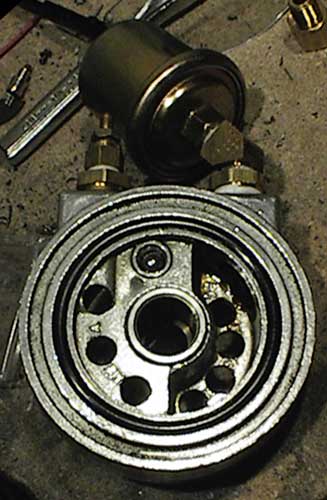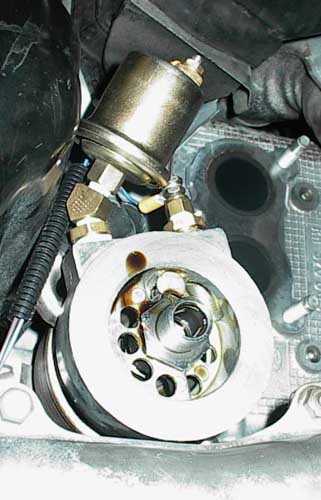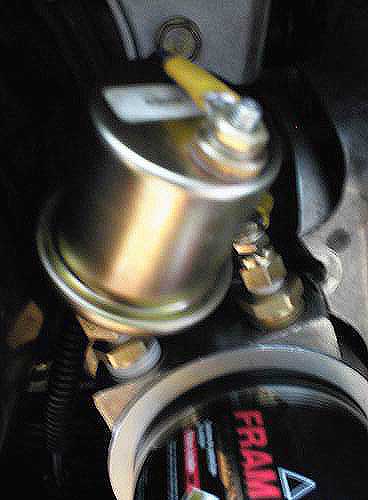
v1.0.0 - Scott Perry - 10/07/02
Standard Disclaimer Stuff: Modifying your car can be dangerous, and may void your warranty. This is what worked for me, your mileage may vary. I cannot be held responsible for anything you screw up, or any negative results you may have from following these instructions. Screwing with the oil system can be dangerous, as an oil leak can lead to catastrophic engine failure or fire. Remember, common-sense is your friend! Direct questions / comments to me at www.i-club.com, username: "sperry".
These instructions briefly explain how to modify a Perma-Cool Sandwich #186 for use as an oil sensor galley for the ’02 Subaru WRX (and possibly other cars).
These instructions do not cover the installation and wiring of gauges or sensors. There are other FAQs that cover those topics.
I use Autometer Sport-Comp gauges in my WRX. The probes pictured here are for a 2 1/16" (52mm) Sport-Comp Electric Oil Pressure Gauge (#3327), and a 2 1/16" (52mm) Sport-Comp Electric Oil Temp Gauge (#3347).
When installing oil sensors, you need access to the oil system that is both hot, and under pressure. On the WRX, most people use the auxiliary oil galley located on the top of the engine block (under the alternator) for pressure, and tap the oil drain plug for temperature. I used a oil filter sandwich adapter to centralize the temp and pressure sensors into a single oil galley. There are vendors that sell pre-made sandwich adapters for the WRX, however they are hard to get a hold of and cost around $100. Perma-Cool (an oil cooler company) make similar adapters for their oil cooler that are much cheaper, but require some modification for our purpose.
Using a sandwich adapter for a sensor galley has several benefits. First, the oil flowing through the filter is under pressure, so a pressure sensor will get accurate readings. Second, the oil flowing through the filter is coming directly from the oil pan (IIRC) which is where the oil from the turbo is dumped, so it will be the hottest oil in the system, perfect for the oil temperature sensor. Third, the sandwich adapter is easily removable, so servicing the sensor senders is easy. Fourth, you don't have to tap the oil drain plug, so a fumoto valve can be used. And finally, installing the sensors is much easier in this location than taking off the alternator to get at the auxiliary oil galley on the top of the motor.
The Perma-Cool Sandwich Adapter #186 is the correct part for the WRX
"Fits M20x1.5 threads. Designed to fit most early imports including
Honda, Mazda and Mitsubishi. 1" thick. 3/8" NPT(int) ports for use
with 1/2" oil lines. 2-1/2" and 3-1/8" O-rings included.
(U.S. Patent 4,335,688)."
http://www.permacool.com/Catalog/Cat_page28.html
Unfortunately, this adapter is designed to route oil from the filter through an oil cooler, before returning it to the engine, so it needs to be modified to serve our purpose as an oil sensor galley. The adapter is designed to take the oil returning from the filter in the blue side, route it out thru the cooler via the 3/8" NPT port, back in to the red side's 3/8" NPT port, and then up to the oil return. Since we plan on putting sensors in the NPT ports, the oil will have nowhere to flow, and we'll be forcing the filter bypass to open, and thereby take the filter out of the oil loop (bad!).

The solution is to modify the sandwich adapter so the red and blue sides of the adapter are a single galley. By drilling holes in the red and blue areas (yellow circles), we now allow oil coming from the filter to flow directly into both the red and blue sides, and then to flow from both sides into the oil return.

Here's a picture of the actual adapter. Three holes are drilled in the left side (I didn't want to drill out the existing bypass valve), and four holes are drilled in the right side. I used a 1/4" carbide drill bit, however sine the adapter is aluminum, just about any dirll bit will work, since aluminum is so soft. Just make sure there is plenty of room for the oil to flow through the adapter, without sacrificing the strength of the adapter. The temperature and pressure sensors are attached to the 3/8" NPT ports with 3/8" NPT to 1/8" NPT adapters and plenty of Teflon tape.

Another picture of the adapter turned over, this is the side the oil filter attaches to:

Installing the adapter is not a cakewalk, but it's not too difficult. Follow the instructions included with the Perma-Cool sandwich adapter, and solve some problems along the way. The first problem to solve is finding room for the sensors. The temp probe is fairly small, but the pressure sender is fairly large. As you can see I used a 45 degree elbow to point it down and in a bit to make it fit. This picture was take with my header off. When the header is installed, you'll notice one of the heat shield bolt flanges is in the way, and will have to be cut off (don't worry, there's plenty of support for the shield, and the bolt won't be missed).

I installed the adapter with the pressure sender as close to the oil pan as possible without letting it touch so the sensors will be as far away from the header as possible. Here's the unit fully installed, you can see the cut heat shield flange on the right. The standard WRX oil filter seems to work well, though a larger filter could be used easily. (Sorry this picture's so blurry.. stupid camera!)

Since these pictures were taken, I've cleaned up my install a bit. I cut the heat shield flange to provide more room, and grinded it nice and smooth. Making sure the sandwich adapter doesn't contact the heat shield is important, since that thing gets HOT! You don't want to skew the temp probe readings or burn your oil! I also routed the sensor wires through some heavy fuel-line rubber hose to protect them from the heat of the headers, and used wire loom to protect them throughout the rest of their run through the engine bay.
My gauge readings are pretty stable. Once up to temperature, the oil tends to run around 180-220 degrees. Idle pressure is about 25psi, and at 3000rpm in 5th it's about 80psi.